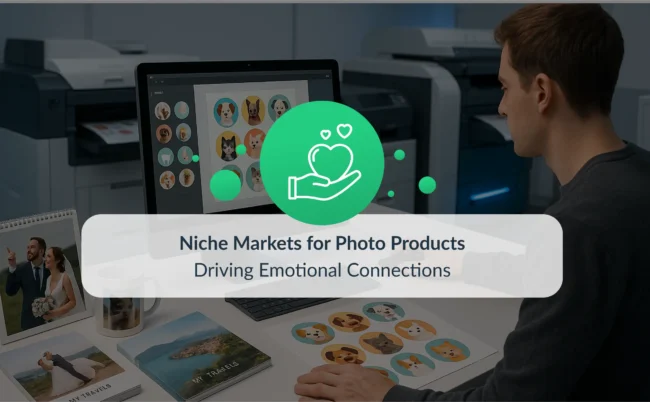Customer support has always been considered inferior to sales. The rise of social media and online recommendations elevated customer support’s status within companies – now some e-commerce experts call it “the new marketing”. Here are some tips on how to approach it on the photo products market.
The basics and the cool stuff
The e-commerce trend to differentiate from other brands through memorable customer support was the answer to the ongoing unification of online stores. Zappos was first to employ these tactics and many others tried to follow suit. Doing something extra for your customer translates into great opinions on the Internet, is immensely shareable, and acts as a marketing tool.
But before you can even think of using your support to promote your brand, you must get the basics right. This usually implies answering calls and replying to emails quickly and not letting your customers wait too long when they want to start a chat conversation with you. Otherwise, every social media post published by your marketing team or by a happy customer will be buried under negative comments left by people who were not satisfied with your services.
In order to arrive at a satisfying level of support, you should experiment with it a bit. Maybe it’s fine for your store to offer only one support channel and that depends solely on your customer base. Teenagers tend to like live chat and social media interactions, older generations are still very much used to phone calls.
Usually, it’s best to have at least two channels at your customers’ disposal, preferably backed up by well-organized self-support. It is highly recommended for the channels to come from the same software provider for full omnichannel experience. Features like contact history and customer identification add extra personalization and improve the speed of support. If for some reason this is not possible, opt for advanced integration between them.

Channels
Self-service
Self-service requires time and thought, but all things considered, it is relatively cheap. Most importantly – it gives the team more time for solving complicated issues and helps it keep sufficiently small for your financial officers to be delighted. The customers like fixing their problems on their own if someone made it easy for them.
How to go about it? Photo products are not the simplest of e-commerce categories out there. A knowledge base on how to create a photobook coupled with an FAQ regarding the purchase, payment, and delivery should do the job very well and be super informative. It is worth considering to send an automatic email order confirmation that would carefully explain the details of the next steps (like delivery) to reduce the number of customer support queries.
The most popular tool for phone self-support is interactive voice response (IVR). Users listen to the voice prompts and use their keypads to perform actions. When done right, IVR can serve the interests of both customers (receiving help) and online stores (reduced number of interactions with customer support, lower operational costs). The secret is to:
- assign most popular queries to numbers like 1 and 2
- make sure not many steps are required to solve the problem (no more than 3 or 4)
- always leave an opening – a possibility to contact live agent for people who got lost
Live chat
Online chat is rising in prominence. Customers are so used to talking via messages with their friends and relatives that they increasingly expect the same from the companies they buy from. Live chat has one very important feature from the customer’s standpoint – it’s real-time. Customers anticipate very good reaction times and instant help, so your organization should be ready to meet those needs if you decide to install a chat widget on your website.
Besides being a great channel for answering simple e-commerce questions, it’s also a great sales support tool when used proactively. Most widgets allow you to display the chat window using various conditions (e.g. “show the chat window only if the customer spends 30 seconds on the subpage Prints”) and this often helps convince hesitating customers to buy.
Social media
Photo products are very visual – many photo products businesses go social and turn their eyes to promoting their offer there and rightly so. The generated interest usually results in comments or messages from customers. If your company is rather small and is not at a fast growth stage, it’s fine to delegate one of the agents to monitor social media channels all the time. When the store gains traction and gets bigger, for a better overall experience integrate social media with your customer support tools. Your support team won’t need to be logged into your social media profiles all the time, full contact history from various channels will be available to them. The team will be able to respond more efficiently.
When it comes to live chat and social media, test a simple chatbot. Forget about AI-driven complicated solutions that still don’t have a feel of a real human-to-human conversation. Just try and use it to automatically answer repetitive questions. The bot can quickly assess that they won’t be able to help and transfer the customer to a live agent. Customer may ask for a transfer themselves as well. The simplest and most important e-commerce queries like order status should be easily dealt with by a chatbot. Chatfuel is a recommended Facebook Messenger chatbot platform.
Emails and contact forms
The biggest mistake one can make is to let the customer support team use email addresses like john.smith@company.com. It wreaks havoc on the organization of work because, naturally, people tend to keep information only for themselves. And whenever a sick leave occurs, it’s virtually impossible to reassign a query from one team member to another. The company loses control over proceedings. It is advised to use one single email (ticketing) inbox. In smaller e-commerce customer care teams usually there’s no specialization, because everybody does everything. The bigger teams need separate queues (e.g. for complaints) within one inbox to manage their work properly.
Contact forms are a great alternative to e-mails. If customer queries are categorized correctly in the drop-down list, the customer support team should be able to prioritize their work better and close tickets more quickly.
Phone
The classic e-commerce dilemma – what type of telephony should be used: landline or mobile? Not to mention that landlines are being superseded by VoIP technology. A mobile phone has one huge advantage: it is, well, mobile. This is so useful when agents need to leave their desks from time to time. But there are many downsides. When an agent fails to answer the call, the company relies only on the agent’s conscientiousness to return the call. That’s very risky. What is more, the calls are not being recorded. It’s very difficult to measure the workload as well. That’s why it’s best to use VoIP (your team doesn’t even need a physical phone – computer, headphones, and good internet connection are enough) with an activated option of forwarding calls to agents’ mobile phones if that’s really needed.
To sum up, there is no universal mix of photo products customer support channels. They all have their pros and cons and are often used at different stages of the customer journey. When you know your customer base very well you should be able to optimize the channel mix to fit their preferences without putting a strain on your company.
If you found this article informative, that’s great, part 2 on customer support processes is coming up soon!




